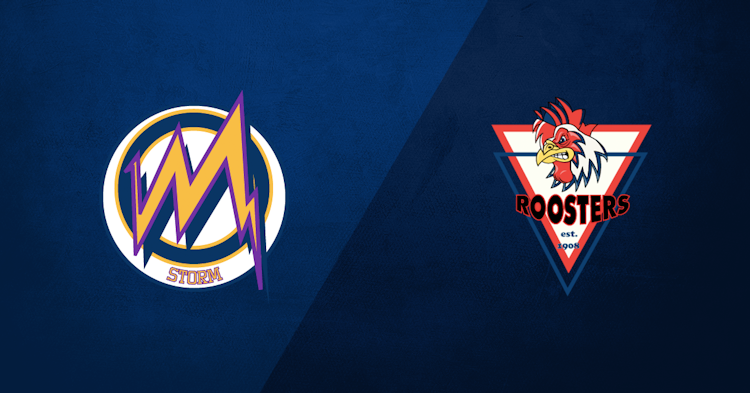Storm vs Roosters: Comparing the NRL Premiership Blueprints
Last updated: May 13, 2020, 4:10AM | Published: May 12, 2020, 10:34PM
The Melbourne Storm and Sydney Roosters are the benchmarks in rugby league.
They have accounted for the last three premierships between them with at least one featuring in six of the last eight Grand Finals. No other team has won the minor premiership since 2013. As the game evolves and players and tactics change, so do the Storm and Roosters.
While considered the best two teams of the last decade, they travel down very different paths to get there every season.
The professionalism of the Storm and their determination to grind out a win is the envy of every club. Meanwhile, the Roosters' ability to shed the latte-loving reputation of Bondi to be one of the toughest teams in the competition props up their exciting style of play.
So, how do these two teams continue to stave off every other team to remain on top?
The Coaches Box
The obvious similarity between the two clubs is the long-standing and elite coaches that front the club. Craig Bellamy and Trent Robinson are two of the smartest minds in rugby league and can manage a team as well as any of the great man-managers we've ever seen. The coaches box is also where the two clubs veer off down different paths until meeting at close to the same location - usually a Grand Final.
Bellamy teams are structured on and off the field. The standard is set on the first day of preseason training and is maintained until the final whistle of that year. Nothing short of 100% effort and accountability will save somebody from a famous Bellamy spray.
His 68.5% winning percentage is the greatest of all-time according to the Rugby League Project (minimum three seasons).
Bellamy has won 310 of his 451 games by preparing for everyone like it's the last the club will ever play. He declined the invitation to the 2016 World Club Challenge as it wouldn't allow the Storm to complete their pre-season training as he would like. As a result of those pre-season trainings, he hasn't lost a Round 1 game in any of his 18 seasons as coach while the Storm haven't tasted a Round 1 defeat since 2001.
In stark contrast to Bellamy, Robinson rested his captain for the first two rounds this season and welcomes the World Club Challenge. He's used it as a team-building exercise and opportunity to expose players to different scenarios.
Robinson's 64.2% winning percentage is incredible, but he's only achieved that across 187 games so far - not even half of Bellamy's output. That 64.2% still has time to look a lot different by the time Robinson's coaching career comes to a close. How far his more long-term view of the game and how he adapts along the way takes him remains to be seen.
Robinson is always looking ahead. Even after winning the 2018 NRL Grand Final, he wasn't satisfied and knew his meticulous planning and constant long-term approach meant there was more success to come.
"We felt like we were on a path to development, but that wasn't an endpoint this season. That's why we were excited about next year."
They then became the first back-to-back premiers in the NRL era.
The two coaches approach their season from different angles, and it translates on the field as well.
Playing Footy
Throughout the Stats the Matter series we highlighted - not so eloquently - that: "Defence wins premierships, and so does attack, just not quite as much."
We know defence wins premierships. A lot of that comes from the discipline installed on the team by the coaches and - while somewhat loathed to use the word - the 'culture' that comes with it. Assigning defensive principles is one thing; putting your body on the line and having the belief those principles will work is a product of the culture elite coaches like Bellamy and Robinson provide.
But you need to score points to win footy games.
The Storm and Roosters score plenty. They're the two best attacking teams since 2015 scoring 23.04 and 22.22 points per game respectively. But again, they come at it from different angles.
Bellamy's players are never left questioning what their role is and where they should be. If they ask the question, you can imagine they're not given the chance to ask many more.
Always in position, they play structured football. "Structure", like "culture", is a word that can often be misused. Every team plays with some sort of structure. In the case of the Storm, it's their ability to always be in shape around the ruck that allows the structure of their attack to be so dominant.
Whether it be Cameron Munster ready to expose a short side or sending the speed and unpredictability of Jahrome Hughes and Ryan Papenhuyzen down the right, the Storm are always in shape to do either. When you've got arguably the best player in the history of the game deciding which way to go from behind every play-the-ball, it's going to translate into try-scoring opportunities.
It's why, unlike the Roosters, the Storm can rely on playing with a little more patience.
They're consistently above the NRL average in completion rates yet below average in offloads - a statistical category most attribute to a potent attack. Instead, the Storm work to areas of the field and wait for the defence to react. Knowing they will be in position to strike when the iron is hot, maintaining possession is key.

Despite playing the most games of any club since the 2015 season (134 games), the Storm have made the third-fewest total handling errors of all 16 teams in that time (662).
The Roosters, on the other hand, have consistently played with a completion rate below the NRL average. They're only three games behind the Storm in total games played, but have made far and away the most handling errors in the competition (865).
The two teams are similar in that they keep their shape at all times - it's why the Roosters were so desperate to poach Cooper Cronk - but the Roosters play a more high-risk and high-error style.
Equally light on offloads, the Roosters use a lot of short passes between forwards, push through the middle, and have been inside the top three teams in supports every season since 2014. They're more likely to force the issue as they look to take every half-opportunity. That might be a speculative offload with the try line in sight, or a short pass from prop-to-prop at the line or as a defender rushes out. Many other coaches might warn against both.
With a tactician like Robinson at the helm, the Roosters pick teams apart and target weaknesses. We've covered off this Roosters try recently already, but it once again highlights how good they are at taking opportunities. James Roberts loves to shoot out from marker and the Roosters know it. Once he starts at Cronk, it's over.
They had a plan to start the set, the defence reacted as expected, and every player was in position to make the most of the try-scoring opportunity.
So, after all that, the Storm and Roosters play with different styles but achieve close to the same results in the wins and points per game columns.
What do they have in common?
Consistency.
It's a dirty word in rugby league these days.
It's demanded in every facet of the game, but it's never going to eventuate.
The Storm and Roosters, however, apply it best with how they set up their club and approach each season.
They have a long-term coach who has been able to massage their ideas into the club over time; anybody new coming in now knows exactly what to expect.
Bellamy has been at the Storm for 17 years - the longest tenure of any current coach at a club. Robinson slots in at second as he approaches eight years with the Roosters. Quite fittingly given the improvements in 2019, Ricky Stuart is next in line. The Raiders could well be the next example of how to breed success in the NRL if they can back up their 2019 Grand Final appearance with another strong season in 2020.
On the field, both Bellamy and Robinson have the luxury of long-term players in key playmaking positions.
Bellamy boasted arguably the best spine in rugby league history when he was able to send Billy Slater, Cameron Smith and Cooper Cronk onto the field together. Meanwhile, Robinson has had Jake Friend behind the ruck his whole career at the Roosters. If not for being stuck behind the best player of all time, Friend would have played out a lengthy representative career. Before Cronk arrived in Bondi, Mitchell Pearce pulled the strings at halfback for 238 games.
Players come and go through a club, but familiar faces consistently filling key positions - including the coaches box - drives success.
While the Titans, Warriors, Tigers, Bulldogs and Knights struggle and look to new coaches and big signings to change their fortunes, they're delaying the necessary period of consistency to develop long-term success.
It's how the Storm and Roosters continue to rack up Grand Final appearances and remain the benchmarks of the NRL season after season. Once again, they opened 2020 as the two preseason favourites according to the Stats Insider Futures Model. Neither looks as though they're going to fall by the wayside anytime soon either.
It's up to the rest of the competition to catch up.
Did you enjoy this article? Join our free mailing list to get the best content delivered straight to your inbox, or join the conversation by leaving a comment below or on the Stats Insider Twitter or Facebook page.



